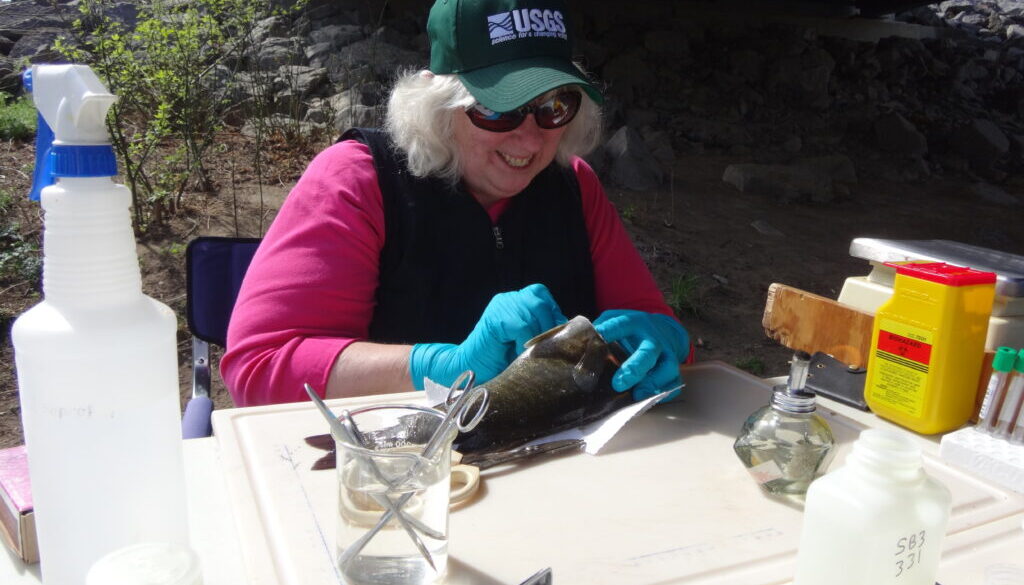“PFAS are everywhere” – Fears growing about PFAS in pesticides
Vicki Blazer has studied the health of the smallmouth bass in the Chesapeake Bay watershed for more than 20 years. As a research fishery biologist for the United States Geological Survey (USGS), she keeps a close eye on pollutants and other environmental factors that could be causing diseases and die-offs plaguing the popular sportfish.
Increasingly, her findings – and her fears – are focused on per- and polyfluoroalkyl substances (PFAS) and how pesticides containing types of PFAS chemicals appear to be accumulating in the fish. Just as she has found contaminated fish downstream from military bases, where PFAS-laden firefighting foams have been used, Blazer is detecting PFAS in the blood of fish in waters near agricultural and forested areas.
Blazer suspects that the PFAS pesticides are running off farm fields into waterways, where they may be contributing to a range of parasitic, viral and bacterial infections in fish that signal compromised immune functions.
Blazer said it is not clear if the PFAS contamination she is seeing is from pesticides or from PFAS-contaminated sewage sludge applied as fertilizer to farm fields, though she suspects both are at play.
“The big takeaway,” she said, “is that PFAS are everywhere.”
“All kinds of impacts”
Blazer is among a growing number of researchers and environmental advocates whose work is increasingly pointing to PFAS in pesticides as an emerging issue of concern, particularly because pesticides used in agriculture not only can impact wildlife but also humans, as pesticide residues are commonly found in finished foods people regularly consume.
PFAS are a class of thousands of chemicals used for decades in a wide range of industries. They are known as “forever chemicals” because they do not readily break down and can persist indefinitely. Some PFAS chemicals have been linked to health harms including certain cancers, liver damage, thyroid problems and reproductive issues.
Among the efforts to rein in PFAS use is a growing movement to restrict PFAS use in pesticides.
“Industry likes to tout how they don’t have to reapply them as often, but they’re accumulating in soil, in crops and in water, and it’s having all kinds of impacts on living things,” said Bonnie Raindrop, program manager at the Maryland Pesticide Education Network.
The organization issued a report in May flagging PFAS pesticides as an emerging concern in the Chesapeake Bay, and has been working with other organizations to pass a bill that would phase out PFAS pesticides in the state. The issue has sparked fierce opposition from industry, Raindrop said.
Pushing for more
Even as environmental and public health advocates battle to cut back exposures to PFAS pesticides, the chemical industry is pushing for more.
Since the New Lede reported in May that a new active pesticide ingredient containing PFAS was poised for approval, the US Environmental Protection Agency (EPA) has taken under consideration two more PFAS pesticides for registration, trifludimoxazin and diflufenican, both broad-spectrum herbicides used to kill broad leaf and grass weed species.
Four of five new pesticide ingredients pending approval under the new Trump administration qualify as a PFAS under an internationally accepted definition though not under a narrower definition followed by the EPA.
The agrochemical industry is pushing for approvals of many new ingredients for pesticides now, said Nathan Donley, environmental health science director at the Center for Biological Diversity. PFAS use in the mixtures are “clearly the trend in the industry,” because they linger for a long time on crops, he said.
PFAS pesticides account for 14% of all active ingredients in pesticides, according to a study Donley co-authored last year. Pesticides may also contain PFAS in their inert ingredients, or the PFAS can leach into the pesticide mixture from contaminated containers, but Donley said that active ingredients are the most worrisome source.
Of 471 “unique, conventional active ingredients” currently approved for use in the United States, 66 met the definition of a PFAS under the standard set by the Organization for Economic Cooperation and Development (OECD), the study states.
“I think this a huge oversight from EPA, these active ingredients [that are PFAS], because they are really designed to be harmful to life,” Donley said.
Donley’s research found 29 PFAS active ingredients and breakdown products in hundreds of US streams from 2013 to 2017.
EPA did not respond to a request for comment about the spate of PFAS pesticides that are up for approval.
Experts worry that as these highly persistent pesticides linger in the environment they will break down into other fluorinated chemicals that could cause long-lasting harm to soil and aquatic organisms, wildlife and humans. Trifludimoxazin for instance has a half-life of 52 days, but one of its metabolites has a half-life of 488 days.
Many PFAS pesticides eventually break down into trifluoroacetic acid, or TFA, which has a half-life in the hundreds of years, and has been linked in preliminary research to cancer, diabetes and reproductive problems. TFA is emerging as a major global water pollutant, that is contaminating food and European wines. Groundwater concentrations of TFA in Europe map closely with agricultural areas, pointing to PFAS pesticides as a major pollutant source.
Mounting Evidence
In her most recent work on PFAS, Blazer collected water and sediment samples at four sites in the Chesapeake Bay watershed from 2014 to 2019, and analyzed them for 105 pesticides, including 16 containing PFAS.
Two PFAS pesticides, fipronil and norflurazone, and their breakdown products, were frequently detected in waters near agricultural land use areas, while four other PFAS chemicals were found in every blood sample collected from smallmouth bass, regardless of location.
PFOS, or perfluorooctanesulfonic acid, was found at the highest levels. PFOS, a breakdown product of Sulfluramid, a now-banned pesticide, and has been used for years in an array of products. It has been previously shown to accumulate to “levels of concern in fish,” according to the EPA.
“It’s never cause and effect when you look at wild fish, because they’re exposed to so many things, Blazer said. “But are we seeing associations with some of the health effects we see in the bass with PFAS concentrations.”
Blazer’s colleague, Emily Woodward, a USGS research physical scientist, similarly found
PFAS pesticides in California’s Sacramento and San Joaquin valleys. Speaking at a webinar in December, Woodward said she found 14 PFAS pesticides at 10 different sites in the two valleys during 2021.
One type of PFAS she detected in 80% of samples, fluopyram, sold for its ability to kill fungal diseases like rusts, blights and mildews, induces thyroid cancer and kidney damage in mice, though its human health impacts aren’t well known.
Fluopyram is widely found in soil and water in Europe as well. A recent study of Germany’s Rhine Valley found the fungicide in more than 90% of samples, including at the tops of mountains surrounding the valley, where rainwater transports it.
Study author Carsten Brühl, professor of community ecology and ecotoxicology at the European Institute for Environmental Sciences in Landau, said that fluopyram harms many life forms. One of its breakdown products causes growth disorders in grapevines, and it is also sold for its ability to kill roundworms in the tropics.
“We have this crazy compound out there, in huge volumes, that is a fungicide, an herbicide, and kills other life forms as well, maybe also insects, and it will surely contaminate groundwater,” he said.
Food Residues
Researchers say a key concern with PFAS pesticides is the fact that commonly consumed foods often carry residues of the chemicals.
US Department of Agriculture data shows that 33 PFAS pesticides were detected on food from 2017 to 2023, according to Alexis Temkin, senior toxicologist at the nonprofit research and advocacy Environmental Working Group. Fluopyram was among the most commonly detected, found in samples of baby food, carrots, eggplant, frozen blueberries, blackberries, grapes, grape juice and tomatoes. Thirty-nine commodities had at least 5% of samples with one or more PFAS pesticides, according to data shared by Temkin in a 2024 presentation. All 52 commodities examined had residues of at least one type of PFAS pesticides, she said.
PFAS pesticides, including fungicides, insecticides and herbicides, are “widely detected” in US foods, said Temkin.
Individual pesticide residues are typically found at levels considered safe by regulators, but researchers worry about the cumulative impact of repeated consumption of residues of multiple pesticides.
A Danish study found that PFAS pesticide detections on fruit, vegetables, cereals, animal products and processed commodities skyrocketed from 24 in 2006 to 412 in 2022.
(Featured photo is of Vicki Blazer, research fishery biologist at the US Geological Survey.)





July 1, 2025 @ 7:45 am
Meg:
Great article but EWG consistently misses the fact that at least 10% of all pesticide formulations are packaged in fluorinated plastics containers. Hence the EPA’s efforts regarding Inhance, the sole provider of fluorination services for post molded containers. There are approximately 150 – 200 million ag chemical containers fluorinated yearly and post use these containers are then triple washed and recycled into agricultural irrigation piping carrying those PFAS compounds right into the ground water.
Thus, not only do you have PFAS compounds in the pesticides themselves and in the sludge, but also on the fluorinated container surfaces which then migrate to the contents or to the irrigated water supply. This phenomenon needs to be brought out to the public more than it has been previously.
July 1, 2025 @ 6:37 pm
True, and something we have reported on in the past. Thank you for highlighting that important point.
June 30, 2025 @ 1:20 pm
Great work and I want to thank you so much for taking these issues on for the public who is so naive.
June 30, 2025 @ 3:21 pm
Thank you for your interest and your feedback!